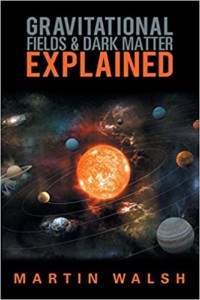 Title: Gravitational Fields and Dark Matter Explained
Title: Gravitational Fields and Dark Matter Explained
Author: Martin Walsh
Publisher: XlibrisAU
ISBN: 978-1543409970
Pages: 60
Genre: Non-Fiction, Science, and Educational
Reviewed by: Dr. Gerhert Gertz, Ph.D.
Pacific Book Review
Martin Walsh set out to clarify the understanding of the workings of gravity and its relationship with Dark matter in his book appropriately titled Gravitational Fields and Dark Matter Explained. In adherence with Newtonian physics, which is discussing only the aspects of interactions which can been seen and repeated, versus the theoretical physics such a Dr. Michio Kaku who uses Quantum Physics including the String Theory and Gravitons as root elements in explaining the force of gravity, Walsh begins with clear and easy to understand examples. His definitions of terms and concepts ride on the coattails of scientists including: the Medieval Willian of Ockham, a philosopher who is credited by separating science from religion; Dr. Stephen Hawking with his many unique contributions; Johannes Kepler’s rules stating Nature finds simple answers; and of course Albert Einstein with his space, time and gravity relationships. These are used as a springboard to go directly to the points Walsh brings together in his book. These prior “giants” of the science world have established the necessary foundation for advancing theories and relationships, of which Walsh generously articulates kinetic energy and Dark matter for his readers.
Energy in its various forms is neither made nor destroyed, and an object at rest will stay at rest until acted upon by an outside force – we have all learned these laws. Walsh’s examples use simple concepts, such as the compression of a spring, the heat of a matchhead, or the passing through of energy in the popular desktop device housing five metal balls on strings and when one ball on the edge is lifted then dropped, the ball on the opposite edge will lift up, while the balls in the center stay stationary. Walsh then weaves in his heightened understanding of the underlying reasons how such occurrences offer windows into the relationships of energy, gravity and Dark matter.
I found Walsh’s articulation on the way in which the Universe interacts with kinetic energy to have fascinating insight. Walsh explains collapsing stars and other celestial objects emitting gravitational waves, which he describes, are kinetic energy waves in a particular phase. Since energy needs to be absorbed, physical evidence of effects on other objects is observed. Out of this energy comes a force which is Dark matter, essentially non-absorbed kinetic energy, which effects observations in unique and different ways, offering an explanation for previously unexplained variations of predictable events.
Walsh separates the book into two parts. The latter part has an excellent summary of the laws of the stated relationships of energy, gravity, and Dark matter. These bullet points are the extract of the prior pages, and Walsh even addresses questions to the reader to further help develop a clear understanding.
As a rather short book of approximately two dozen pages, upon completing this book I then made coffee and re-read it for a second time. The more time readers spend on each sentence the more enlightenment and pleasure readers will get from gaining new insight into the Universe’s existence. As it is generally realized the more one knows, the more one knows how much more there is to learn, Walsh’s work is a tangent of understanding to the accomplishments of other physicists and philosophers in determining the elemental structures of our Universe. He further postulates, as with Johannes Kepler, simplicity from Nature forms the strongest conclusions.
His reading audience is from young adults on up, Gravitational Fields and Dark Matter Explained will prove to be very thought provoking for inquisitive minds; a worth-while addition to all wishing to gain a heightened awareness of existence. While much of the science is complex, the style makes it easy to digest, without watering down the concepts. My recommendation is Martin Walsh’s writing goes very well with a cup of strong coffee. I highly recommend this wonderful little book to all science enthusiasts and anyone else that might want to take a peek into our present understanding of just what the Universe is made of. This book is worth reading to keep the mind working and looking at things in new ways.

